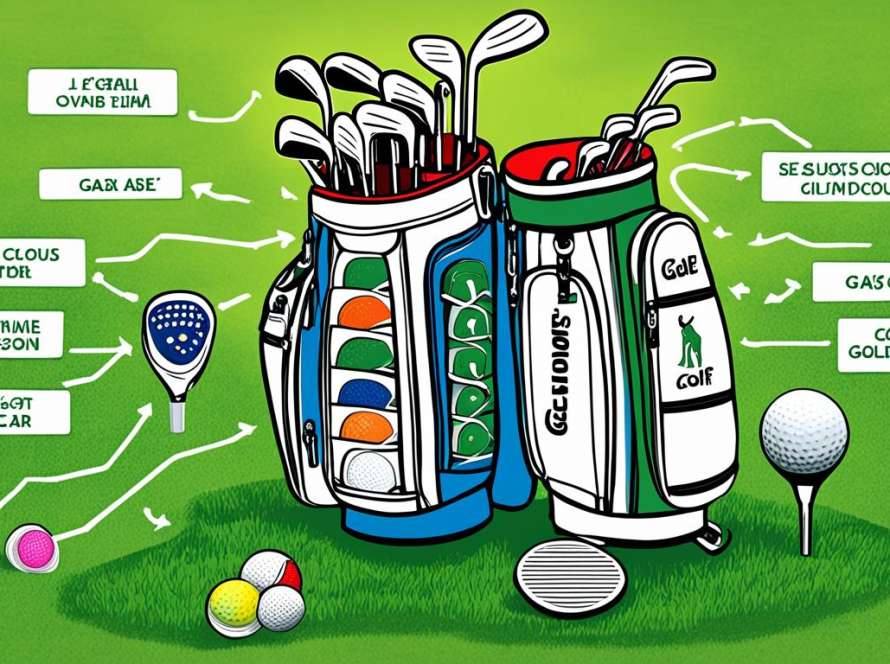To improve your golf swing, focus on arm mobility. Having relaxed arms helps you hit effortless and consistent shots. By easing up in your backswing, you’ll make your swing mechanics better and see better results on the course.
Learning how to extend your arms properly is key to building swing power. By keeping your arms lower during the backswing, you’ll cut down on tension. This makes your swing mechanics better. This guide will show you how important arm mobility is and give you tips to boost your game.
Understanding the Importance of Arm Mobility in Golf
Arm mobility is key to your golf swing. It boosts your power, accuracy, and overall performance. A good golf swing guide shows how arm flexibility helps with a smooth, efficient swing.
The Role of Arms in Golf Swing Mechanics
Your arms link your body to the club, making a fluid golf swing. They transfer energy from your core to the ball. With the right arm movement, you get a full swing arc and better control at impact.
How Arm Mobility Affects Power and Accuracy
Good arm mobility lets you swing harder and hit more accurately. It helps you swing wider, making the clubhead go faster. Flexible arms also keep the swing plane right, leading to consistent hits.
| Arm Mobility Level | Effect on Power | Effect on Accuracy |
|---|---|---|
| High | Increased clubhead speed | Better control and consistency |
| Low | Reduced swing arc | Inconsistent ball striking |
Common Arm-Related Issues in Golf Swings
Many golfers struggle with arm mobility, which can mess up their swing. These problems can affect your shoulder turn and swing plane. Some common issues include:
- Limited external rotation in the lead shoulder
- Restricted internal rotation in the trail shoulder
- Decreased shoulder flexion
To fix these problems, add shoulder turn drills and swing plane training to your practice. These exercises can greatly improve your arm mobility and golf swing.
The Anatomy of Arm Movement in Golf
Understanding how your arms move in golf is key to a better swing. The shoulder joint is crucial for your golf technique. It’s a ball-and-socket joint called the glenohumeral joint. This joint lets you move your arm in ways needed for a good golf swing.
Your shoulder joint helps with rotation, bending, and straightening your arm. These actions are key for powerful and accurate shots. The glenohumeral joint works with other parts to make your swing smooth and effective.
How your shoulder blade moves is also crucial for arm mobility in golf. It slides along your ribcage, giving stability and support during your swing. This movement keeps your shoulders in the right spot and makes your swing fluid.
| Joint | Function in Golf Swing |
|---|---|
| Glenohumeral Joint | Allows arm rotation and wide range of motion |
| Scapulothoracic Joint | Provides stability and supports shoulder movement |
By focusing on these parts, you can make your golf swing better. Knowing how your shoulder joint and scapular movement work together can improve your game. A good golf swing depends a lot on these structures moving smoothly together.
Arm Mobility in Golf Swing Guide: Key Techniques
Mastering arm mobility techniques is key to a better golf swing. This guide will show you how to move your arms for better performance on the course.
Proper Arm Position During Setup
Your arm position at the start of your swing is crucial. Keep your arms relaxed and let them hang from your shoulders naturally. Bend your hips a bit, allowing your arms to swing freely. This helps you start your swing smoothly and keeps the swing plane right.
Maintaining Arm Connection Throughout the Swing
Keeping your arms connected is key for hitting the ball well. Make sure your lead arm (left for right-handed golfers) stays close to your chest in the backswing and downswing. This keeps the swing wide, adding power and accuracy. Practice this with slow swings to remember it better.
Achieving the Ideal Arm Rotation
Right arm rotation is crucial for speed and control. In the backswing, let your lead arm turn outward, making a 90-degree angle with your upper arm at the top. Then, your trail arm turns inward on the downswing, making the clubface square at impact.
| Swing Phase | Arm Position | Key Focus |
|---|---|---|
| Setup | Relaxed, hanging naturally | Promote fluid takeaway |
| Backswing | Lead arm close to chest | Create wider arc |
| Top of Swing | 90-degree angle in lead arm | Generate power |
| Downswing | Trail arm rotates internally | Square clubface at impact |
Adding these arm mobility techniques to your golf training will boost your swing. Practice these moves often to build muscle memory and see better results on the course.
Assessing Your Current Arm Mobility
Improving your swing starts with a golf mobility assessment. It shows where you need to work and guides your training. Let’s look at how to check your arm mobility for golf.
First, check your shoulder range of motion. Stand with your arms at your sides. Slowly raise them overhead. If you can’t reach full extension, your shoulder flexibility might be limited. This can affect your backswing and follow-through.
Then, test your wrist flexibility. Hold your arms out in front of you. Flex and extend your wrists. If you have trouble moving your wrists, it could impact your club control and swing speed.

Elbow mobility is also key. Try touching your shoulders with your hands. If this is hard, you might need to work on elbow flexibility. This affects your arm position during the swing.
Here’s a simple table to help you assess your arm mobility:
| Joint | Test | Good Range | Limited Range |
|---|---|---|---|
| Shoulder | Arm raise | 180 degrees | Less than 160 degrees |
| Wrist | Flexion/Extension | 90 degrees each way | Less than 70 degrees |
| Elbow | Touch shoulder | Full contact | Gap between hand and shoulder |
These flexibility tests are just the beginning. For a full golf mobility assessment, talk to a golf fitness professional. They can give you detailed advice and exercises to boost your arm mobility and golf performance.
Essential Stretches to Improve Arm Mobility
Arm mobility is key for your golf swing. Adding specific stretches and exercises to your routine can boost your game. Let’s look at some key drills to increase your arm flexibility and power.
Shoulder Rotational Exercises
Begin with shoulder rotations to loosen your upper body. Stand straight, extend your arms, and make small circles. Then, increase the circle size. This exercise helps improve your shoulder motion, crucial for a smooth backswing.
Wrist Flexibility Drills
Wrist flexibility is crucial for controlling the club at impact. Here’s a drill: extend your arm, palm down. Use your other hand to pull your hand back towards your forearm. Hold for 15 seconds, then switch sides. Repeat to boost wrist mobility and prevent injuries.
Elbow and Forearm Stretches
Don’t forget about your elbows and forearms. A good stretch is extending your arm straight out, palm up. Then, use your other hand to pull your fingers back towards your body. Hold for 20 seconds, then switch arms. This stretch helps the muscles used in your swing, improving arm mobility.
| Stretch Type | Duration | Frequency | Benefits |
|---|---|---|---|
| Shoulder Rotations | 30 seconds | 2-3 times daily | Improved backswing |
| Wrist Flexibility | 15 seconds per side | Before and after rounds | Better club control |
| Elbow/Forearm Stretch | 20 seconds per arm | Daily | Enhanced swing power |
Make these mobility drills part of your daily routine and warm-up before playing. With regular practice, you’ll see better flexibility and a smoother golf swing. Always stretch gently and stop if you feel pain or discomfort.
Strength Training for Enhanced Arm Mobility
Strength training is key for better arm mobility in golf. Adding golf-specific exercises to your routine can boost your swing power and accuracy. Let’s see how exercises can help improve your arm mobility on the course.

Golf-specific training targets muscles used in the swing. This includes your shoulders, rotator cuffs, and upper body. Strengthening these areas helps with stability and control in your swing.
Resistance exercises are vital for building strength and better arm mobility. Use resistance bands or light weights for exercises like:
- Shoulder rotations
- Scapular retractions
- Serratus anterior pushups
- Forearm curls and extensions
Functional fitness exercises also help. They mimic the movements you make in your golf swing. These exercises improve strength and flexibility, leading to better arm mobility. Try adding these exercises to your routine:
- Medicine ball rotational throws
- Cable machine rotations
- Single-arm dumbbell rows
- Kettlebell swings
Start with light weights and increase them as you get stronger. Being consistent with your training is important. Aim to do these exercises 2-3 times a week for the best results. With regular strength training, you’ll see better arm mobility and golf performance.
Integrating Arm Mobility Exercises into Your Golf Routine
Arm mobility is key to your golf game. Adding specific exercises to your routine can boost your swing and lower injury risks. Let’s see how to easily add arm mobility work to your golf practice.
Pre-Round Warm-Up Techniques
Starting with a good golf warm-up is crucial. Begin with some light cardio to get your blood flowing. Then, move on to dynamic stretches for your arms and shoulders.
Try arm circles, shoulder rolls, and wrist rotations. Do each for 30 seconds to wake up your muscles without getting tired.
Post-Round Cool-Down Stretches
After your game, cool-down exercises are a must to prevent stiffness and aid recovery. Use static stretches now. Hold each stretch for 15-30 seconds, focusing on shoulders, biceps, triceps, and forearms.
These stretches improve flexibility and lessen soreness after the game.
Daily Mobility Practices for Golfers
Being consistent with arm mobility exercises is important. Add daily mobility drills to your routine, even on days you’re not golfing. Mix stretches with light resistance exercises to boost your arm flexibility and strength over time.
| Exercise | Frequency | Duration | Benefits |
|---|---|---|---|
| Arm Circles | Daily | 1 minute | Improves shoulder mobility |
| Wrist Flexor Stretch | 3-4 times/week | 30 seconds each arm | Enhances wrist flexibility |
| Tricep Stretch | Daily | 15-30 seconds each arm | Increases arm extension range |
| Shoulder Blade Squeeze | 5-6 times/week | 10-15 reps | Strengthens upper back muscles |
Stick with these practices to see better arm mobility, leading to a smoother and stronger golf swing. Always pay attention to your body and adjust the intensity to avoid overdoing it.
Common Mistakes and How to Avoid Them
Golf swing errors can really affect your game. Many golfers face issues with their arm mobility. Tensing up your arms and shoulders during the swing is a common mistake. This limits your movement and cuts down on power. To fix this, keep your arms relaxed during the swing.
Lifting your arms too high in the backswing is another error. It can mess up your balance and timing. Instead, aim for a shallower arm position. This keeps you in control and makes your swing more consistent. Remember, a smooth swing usually beats a forceful one.
Not rotating your shoulders properly is another mistake that can hurt your game. Your shoulders are key to power and accuracy. To fix this, start your downswing with your lead hip, not your arms. This helps you swing more smoothly and powerfully.
Regular practice is essential to improve. Focus on your arm mobility and technique. With time and effort, you’ll see your golf swing and game get better.

